Jessica Loredo • Discovery Education • December 2024
How a Data-Driven Approach Led to More Engaging and Effective Design Meetings
When our design team at Discovery Education transitioned to a more decentralized model, we faced a growing challenge—our collaboration and feedback spaces were no longer serving the team effectively. Meetings lacked structure, participation was inconsistent, and designers often felt disconnected from their colleagues.
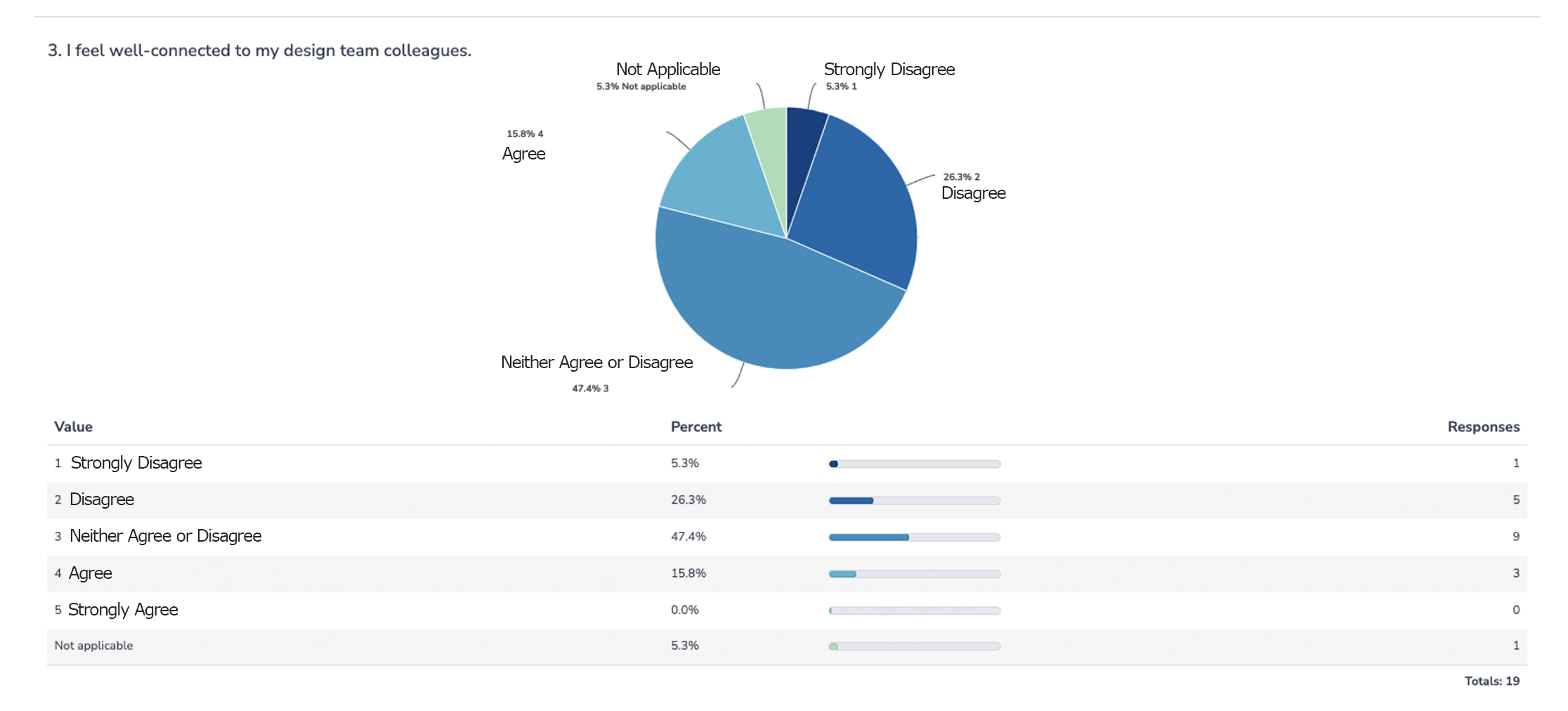
How could we create a community that elevates design quality through critique and transparency while also fostering engagemenet and connectedness?
Through a data-driven, iterative approach, I led a transformation of our design team’s key meetings—Design Jam, Bi-Weekly Team Meeting, and Small Group Critique Sessions. Over multiple surveys and refinements, we redefined how we collaborate, ensuring that our meetings provide clarity, connection, and continuous feedback. Keep reading for more!
The Problem
Low Engagement & Unclear Purpose in Design meetings
Prior to our iteration efforts, the Design Jam meeting lacked clarity and structure. While the intent was to create a space for designers to showcase their work and receive feedback, participation remained low, and only the most vocal designers engaged.
Key pain points from team feedback:
- Lack of structure: Designers weren’t sure what to present or how often.
- Low participation: The same designers spoke up while others stayed silent.
- High time investment: Designers felt pressure to create polished presentations rather than share work-in-progress.
- Limited connection across teams: With the team growing and becoming more decentralized, collaboration across product lines became more difficult.
Key pain points from team feedback:
- Unclear focus: Many meetings felt like open-ended discussions rather than strategic alignment.
- Repetitive discussions: Some meetings lacked action-driven outcomes.
- Discomfort speaking up: 41.2% of designers admitted they felt uncomfortable speaking in larger meetings.
It was clear we needed a fresh approach—one that focused on structured collaboration, lower friction for participation, and fostering engagement across teams.
The Approach
Survey-Driven Insights & Iterative Changes
To understand the needs of our design team, I led two key surveys (Q3 2023, Q2 2024) to gather qualitative and quantitative data on team collaboration and meeting effectiveness.
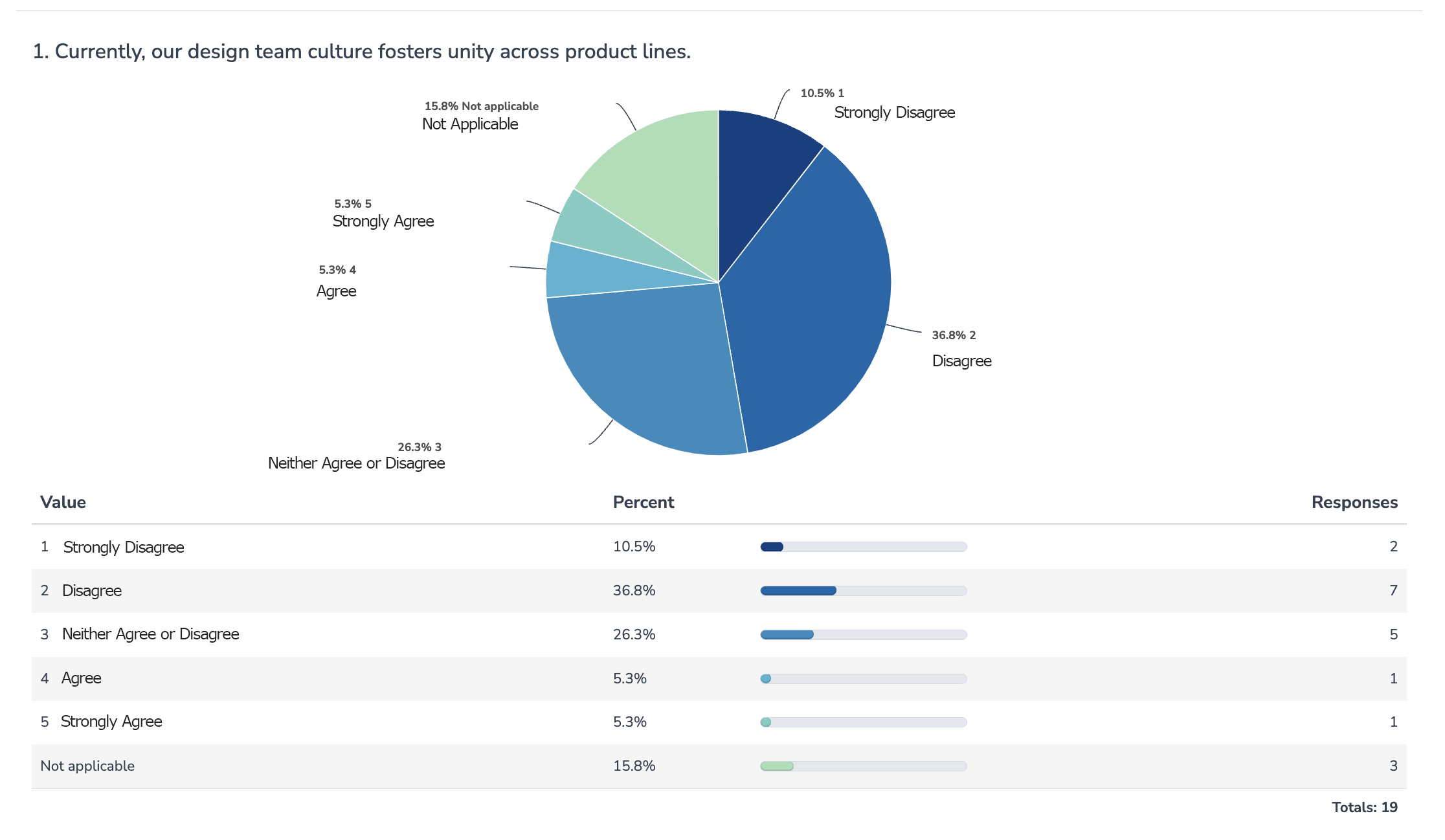
The survey data revealed:
- Designers felt disconnected from one another and across product lines
- Designers wanted structured critique but in smaller, iterative groups.
- Meetings needed clearer purpose and better facilitation.
- Transparency and visibility into team projects were highly valued.
Armed with this data, I outlined a strategy to improve our design meetings through structured experiments and piloted iterations. I focused on improving our Design Jam meeting through 2 iterative formats, and created a new meeting ritual for our team as design critique working groups. I also provided feedback to my boss on his K-12 biweekly meeting which led to some minor changes to make it more structured.
Design
Iteration 1: Structuring Design Jam for Better Participation
Goal: Increase participation by making sharing structured and predictable.
We took a hard look at our Design Jam meeting and gave it an overhaul in terms of format and created a Figjam template to help ground the team and provide a scaffold for working inside of the file.
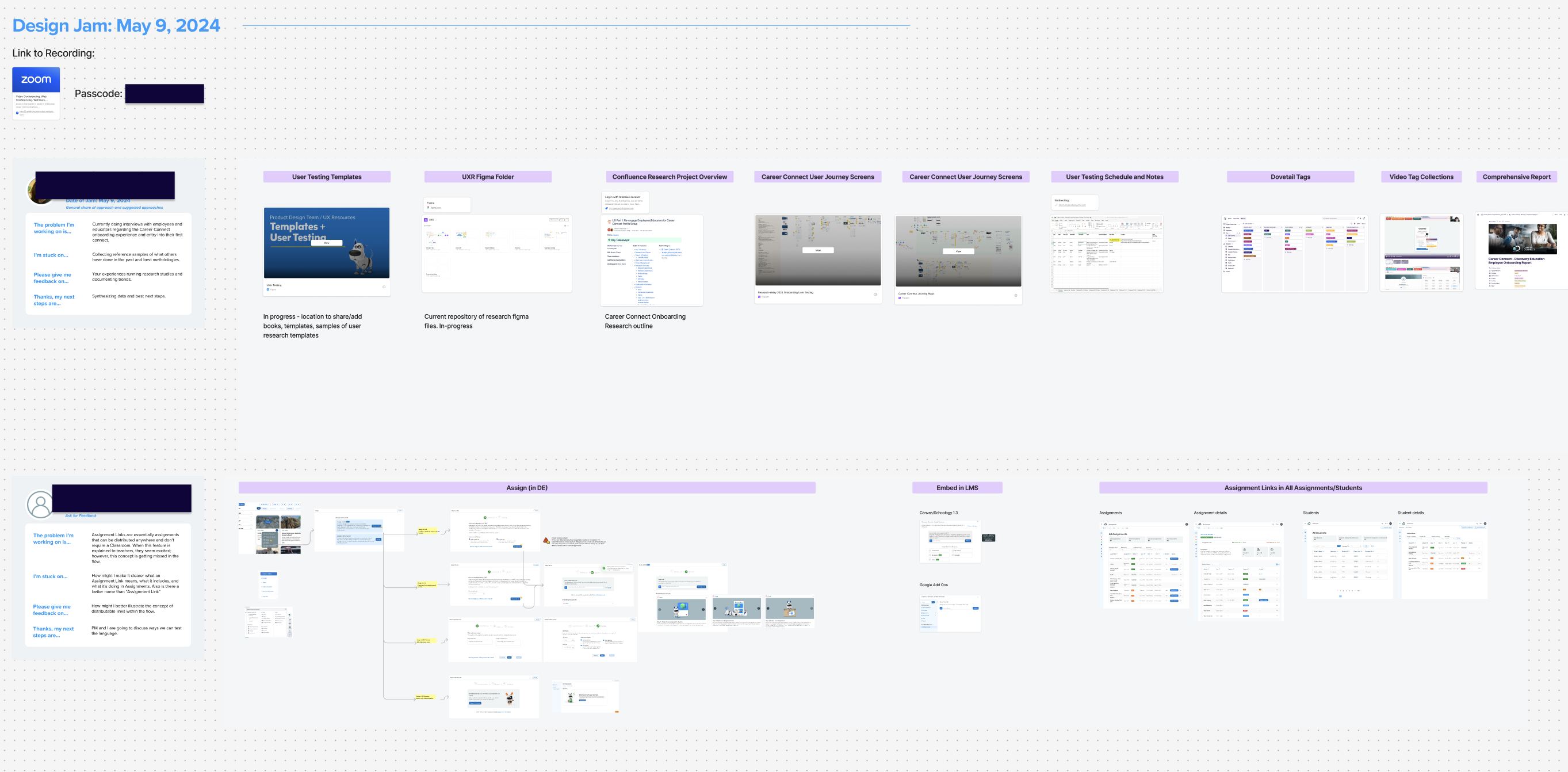
Results
- Introduced a rotating schedule → Three designers shared in each session, ensuring more diverse voices.
- Added visibility → A calendar helped designers prepare for their turn in advance.
- Qualitative feedback from designers highlighted that hearing from designers who rarely presented in previous format was a pleasure and fostered engagement.
After using the new format for about six months, I gathered feedback from the team and sought to make some udpates based on the feedback. This led to a slightly altered format and clearer objectives for the meeting. We decided Design Jam would focus on team connection and visibility, while smaller group critiques would focus more on deep critique in smaller spaces.
Iteration 2: Lowering the Barrier to Sharing & Increasing Connection
Goal: Reduce preparation pressure and make it easier for designers to share.
- Moved to a bi-weekly cadence: To foster more frequent but shorter meeting times.
- Switched to a “scrapbook” format: Instead of structured presentations, designers shared quick snapshots of their professional or personal updates as desired.
- Emphasized transparency over perfection: Encouraged work-in-progress sharing rather than polished decks.
- Created a pilot within our team to test feasibility before including other business units in team meeting.
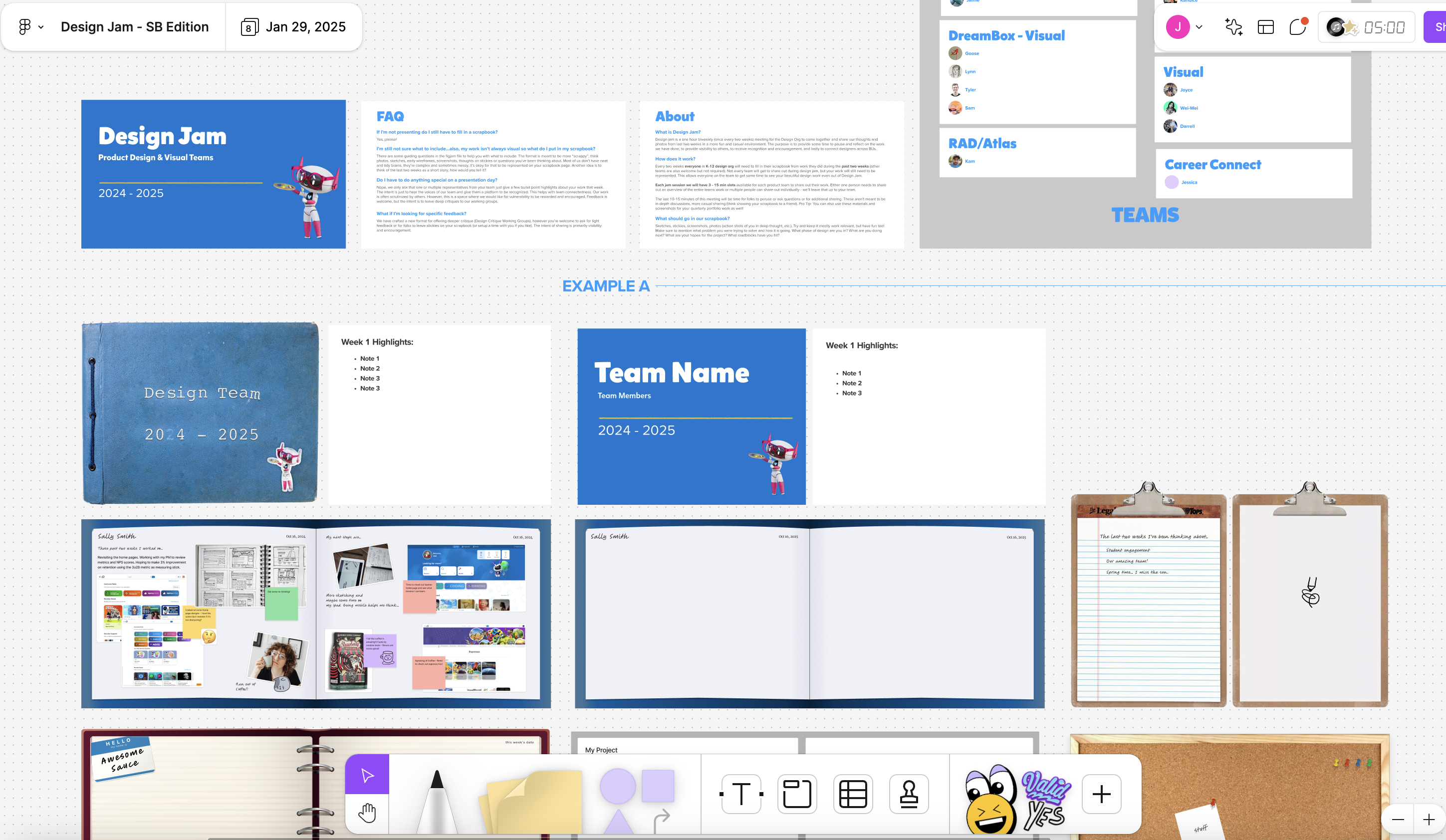
Results
- Lower friction = higher and more frequent participation by most of the team.
- More casual, open discussions, that were more inclusive of more team members.
- Work-in-progress sharing encouraged more iterative feedback.
Once the new format was kicked off, I started a new pilot team ritual in November of 2024, which was slated to run through Q1 of 2025. After Q1, I ran another short 10-question survey to gauge feedback on the new meeting ritual - Design Critique Working Groups (DCWG).
Introducing Small Group Critique Sessions (DCWG)
Goal: Provide more in-depth, ongoing feedback opportunities in a smaller, safer environment.
- Formed small critique groups: Weekly/bi-weekly sessions with the same team for a quarter.
- Encouraged iterative feedback: Instead of one-off critiques, designers got ongoing support from their group.
- Rotated groups every three months: To maintain fresh perspectives while building trust over time.
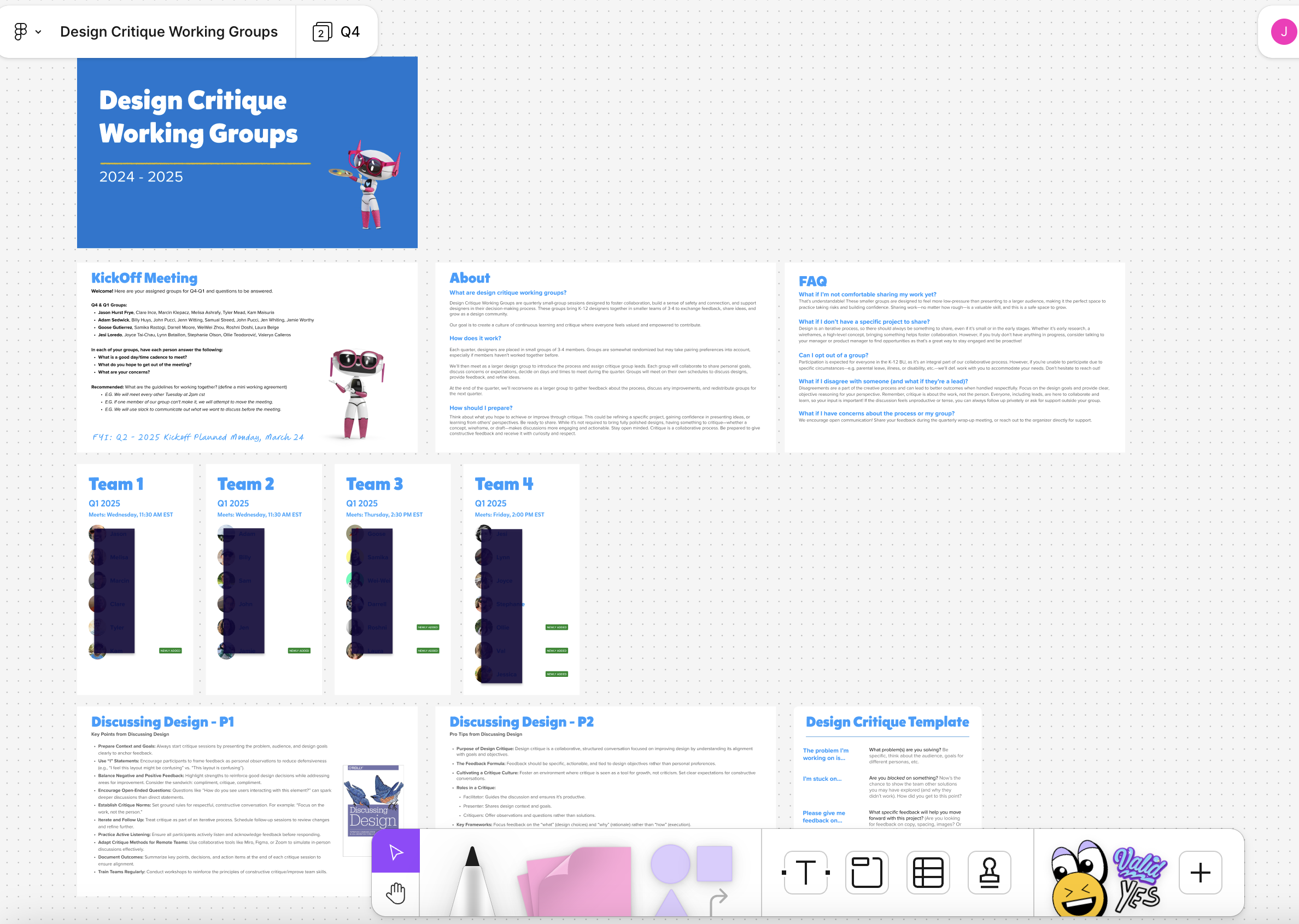
Results
In a team survey conducted in 2024, 30% of the team disagreed that they felt connected to their colleagues. 40% were neutral. Not the greatest stat so one of my key objectives was team connectedness and design quality improvements. After the pilot concluded, the survey was ran for 2 weeks and below are the results.
- 88% of designers felt more connected to their colleagues than before the pilot
- 63% felt their designs improved, or were inspired by the work of their colleagues
- 75% want to continue paricipating in the small group critiques (19% were neutral)
A big success for meeting the key objectives I set forth to tackle. There is still room for improvement as it is clear we need to work on slightly more structured giving/receiving critique to ensure we're providing meaningful feedback. However, for a pilot, excellent traction
In late April or early May of 2025 we will run a large team meeting and culture survey again and we will compare our results of the iterative Design Jams for further quantitative data which can help inform our approach going forward.
Results & Impact
Stronger, More Effective Collaboration Spaces
- Design Jam evolved from a passive showcase into a low-pressure, high-engagement session.
- The Bi-Weekly Team Meeting now has clearer goals, structure, and strategic alignment.
- Small Group Critique fosters meaningful feedback and stronger team relationships.
Key Impact Metrics
- Increased designer participation & engagement in Design Jam
- 88% of designers felt more connected, and 63% felt their designs improved through group critque
- Improved strategic alignment through the Bi-Weekly Team Meeting
These initiatives have fundamentally transformed how our design team collaborates, shares work, and builds relationships. However, I consider this an ongoing project and will continue to iterate and solicit feedback from the team.
Reflection
Lessons Learned & Next Steps
- Clarity Drives Participation: When expectations are clear and low-friction, engagement follows.
- Small, Frequent Feedback > Big, Infrequent Critique: Designers prefer an iterative approach over formal, high-pressure reviews.
- Asynchronous + Real-Time Balance Is Key: Some conversations are best async, while others thrive in live discussions.
- Culture Takes Time: Changes didn’t happen overnight, but incremental shifts helped build momentum.
Next Steps:
- Continue iterating based on feedback.
- Measure impact with another team survey.
- Consider expanding Design Jam to other business units.
By combining team feedback with thoughtful iteration, we created a collaborative design culture that is more inclusive, engaging, and effective.
This case study reflects how thoughtful iteration, survey-driven decision-making, and team collaboration can transform the way design teams work together. By focusing on structure, engagement, and transparency, we built a stronger foundation for long-term success.